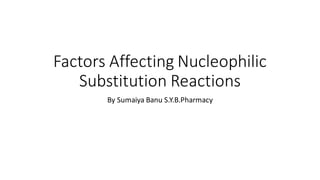
Factors affecting nucleophilic substitution reactions finished d
- 1. Factors Affecting Nucleophilic Substitution Reactions By Sumaiya Banu S.Y.B.Pharmacy
- 2. Four Factors….. 1. Nature Of Substrate 2. Nature Of Entering Group a.k.a. Nucleophile 3. Nature of Solvent 4. Nature Of Leaving Group
- 3. SN1 and SN2 Reactions
- 4. Nature of Substrate SN1(stability) • As there is formation of Carbocation in the SN1 mechanism; more stable the Carbocation more reasonable the SN1 reaction rate • tertiary > secondary >> (primary—unreactive) • Only tertiary halides react by an SN1 mechanism(moststable). SN2(steric hinderance) • Simple alkyl halides show the following general order of reactivityin SN2 reactions: Methyl > primary > secondary >> (tertiary—unreactive) • The important factor behind this order of reactivity is a steric effect, and in this case, steric hindrance.
- 5. • Very large and bulky groups can often hinder the formation of the required transitionstate. In some cases they can prevent its formation altogether. • Tertiary carbocations are stabilized because sigma bonds at three adjacent carbons contribute electron density to the carbocation p orbital by hyperconjugation. Secondary and primary carbocations have less stabilization by hyperconjugation. A methyl carbocation has no stabilization.
- 6. Nature Of Entering Group a.k.a. Nucleophile • Nucleophile: Donate a lone pair of electron • Basicity: nucleophile attackshydrogen • Nucleophilicity: nucleophile attacksany atom other than hydrogen • Nucleophilicity is measured by relative rates of reaction,by how rapidly an electron pair donor reacts at an atom (usually carbon) bearing a leaving group. • Nucleophile does not participate in the rate-determining step of an SN1 reaction, the rates of SN1 reactions are unaffected by either the concentration or the identity of the nucleophile • The rates of SN2 reactions, however, depend on both the concentration and the identity of the attackingnucleophile.
- 7. FACTORS • Nucleophile should be small in size. • Nucleophile should less electronegative. • Nucleophile should be strong Base. • A good nucleophile is one that reacts rapidly in an SN2 reaction with a given substrate [STRONGER BASES]. A poor nucleophile is one that reacts slowly in an SN2 reaction with the same substrate under comparable reaction conditions [WEAK BASES].
- 8. • Methanol, on the other hand, is a poor nucleophile for reaction with iodomethane. Under comparable conditions it reacts very slowly. It is not a sufficiently powerful Lewis base (i.e., nucleophile) to cause displacement of the iodide leaving group at a significant rate: • Methoxide anion, for example, is a good nucleophile for a substitution reaction with iodomethane. It reacts rapidly by an SN2 mechanism to form dimethyl ether:
- 9. Nature of Solvent • Two Types of solvents Polar Non-Polar Polar Protic Polar Aprotic • SN2 SN1 • Can donate H+ ions Cannot donateH+ ions • Solvateboth anionand cation Solvateonly Cation • Eg.: CH3COOH, R-NH2,etc Eg.: DMF, DMSO, HMPT, Acteone,etc
- 10. SN1 and SN2 Reactions
- 11. Two properties affecting rate of reaction: • Ionization Power Dielectrict constant SN1 Highly Polar Polarity SN2 Less Polar Ionization Power • Solvation Power
- 12. Nature of Leaving Group • Weaker the base stronger the leaving group • In either an SN1 or SN2 reaction the leaving group begins to acquire a negative charge as the transition state is reached. • If it were a strong base it will put +ve charge on C atom, which is undesired. • This lowers the free energy of activation and thereby increases the rate of the reaction. • Weaker the bond b/w C and the leaving group, more easy will it be to carry out SN1 and SN2 reaction
- 13. • The hydroxideion, for example, is a strong base and thus reactionslike the following do not take place: • However, when an alcoholis dissolved in a strong acid, it can undergo substitutionby a nucleophile.Because the acid protonatesthe -OH group of the alcohol,the leavinggroup no longer needs to be a hydroxideion;it is now a molecule of water—a much weaker base than a hydroxideion and a good leavinggroup:
- 14. • Among the halogens, an iodide ion is the best leaving group and a fluoride ion is the poorest: • The trifluoromethanesulfonate ion (CF3SO3 -, commonly called the triflate ion) is one of the best leaving groups known to chemists.
- 15. Thank you
